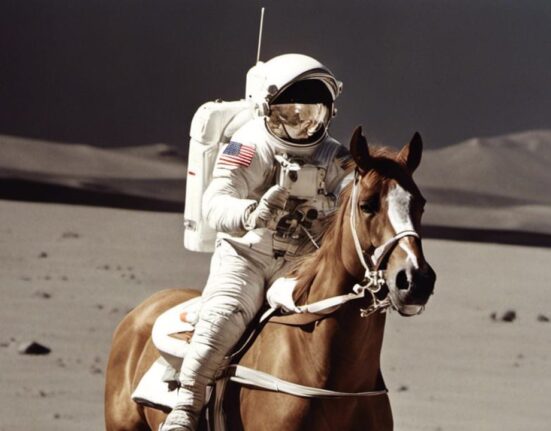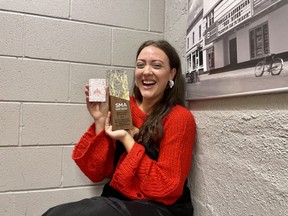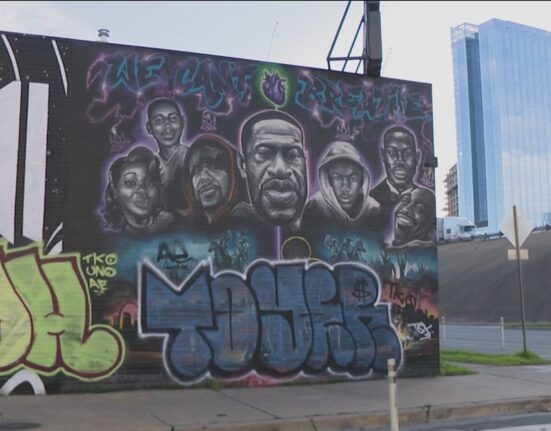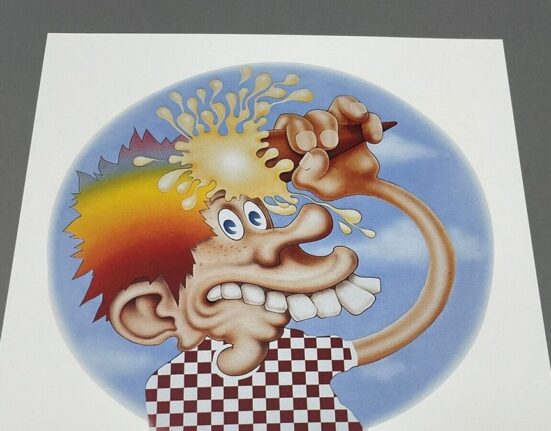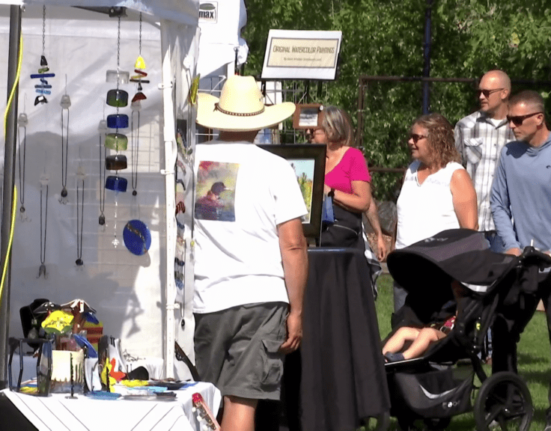It’s a sunny morning in Bristol and I’m looking at a biological clock. Not my own metaphorical one, but an actual one: an hourglass in the form of two uteruses, complete with fallopian tubes. The sand has collected at the bottom: time has run out. The work is by the New York-based artist Lea Cetera, the title You Can’t Have It All. I give a wry laugh.
It’s part of Acts of Creation: On Art and Motherhood, a major group exhibition by Hayward Gallery Touring currently at the Arnolfini gallery, which aims to address a historical blindspot when it comes to mothers who are also artists. Curated by Guardian contributor Hettie Judah, it has been years in the making. As far as she knows, there have been shows about motherhood as an artistic subject, and shows about art made by mothers, but none that address the two entwined: motherhood as lived experience, and an engine for creativity.
Much of the work is revelatory. Judah scoured archives and collections, sometimes discovering a work on the basis of a mere passing reference in a book or academic journal. She lifts a sheet that protects a selection of pencil drawings of labour and childbirth by the Canadian artist Heather Spears, done in January 1987. In all, there were hundreds of drawings: Spears sat with women throughout their labours and drew them in real time, for hours, days, and they are striking in their dynamism and tenderness. I have never seen a baby crowning used as an artistic subject before.
Likewise, the many pregnant, breastfeeding, and nude self-portraits in the exhibition. I expect visitors, mothers especially, will feel a similar sensation of the invisible being uncovered, whether in Ghislaine Howard’s charcoal rendering of her stretchmarks, Camille Henrot’s pumping nude, or Catherine Elwes’ close filming of her own lactating breast.
Caroline Walker’s painting of her sister-in-law’s bottles and pumps drying on a draining board elevates these objects to the status of a canonical still life. “I suppose to me they are quite triggering objects,” Walker, who is about to embark on another painting of her own breast pumps, tells me. “All of this paraphernalia. I didn’t have a very successful breastfeeding experience with either of my babies. So there are memories of sitting in the middle of the night on my own, pumping milk. They are objects that are imbued with this particular moment.”
Having pumped to feed my preterm baby, standing in front of such a painting is an emotional and validating experience. Did painting it help Walker purge some of the emotions? “I’m very Scottish – ‘pull yourself together and get on with it’,” she says. “But I did hold on to an awful lot of that feeling of the guilt, of failure, of my experience of being with a little baby not being quite as I had imagined. I think painting it did help me, because painting is something that I feel confident in. I was taking back control of this subject, in this identity that feels much more stable.”
The sometimes joyful, sometimes harrowing subjectivity of many of the works means that visitors are likely to find something that affirms their own experience. Fani Parali’s mixed media work Incubator/Flight commemorates the time her son was in the neonatal intensive care unit. Her fragile drawing of him, which sits in a steel crib, is so effective at conjuring the vulnerability of a premature baby that I cannot linger by it too long.
In the room dedicated to baby loss, works about personal experiences of fertility treatment, abortion and forced adoption are deeply affecting. Su Richardson’s Heartstrings (What Becomes of the Broken Hearted?) includes a bib and a birthday card given to her by a friend who had been pregnant as a schoolgirl in 1967, and had to give up her baby. The card reads: “1 today wherever you are, Mummy”.
The nucleus of the exhibition – “the temple”, as Judah calls it – has walls of vivid blue and is dedicated to interpretations and subversions of the Madonna and child which take the form of a series of stunning self-portraits. Jai Chuhan’s large canvas, a nude of herself as an exhausted mother painting herself as a younger, pregnant woman while her daughter plays alongside, depicts the tension inherent within the overlapping identities of artist and mother. It was painted in 1995 and though the Arts Council bought the work immediately, Chuhan tells me she felt reticent about it. “I just didn’t think there would be any interest in the subject,” she says. “Sometimes, if you’re a mother as well [as an artist], people don’t take you seriously.”
Chuhan once met Judy Chicago after she delivered a lecture at her university. “She was really inspiring, because she said, if you want to get on, you have to shout. OK, I said. What if you have children? ‘Oh, no, no,’ she said, ‘you can’t have children if you’re an artist.’ So I said, well what if you just had one? So she went, ‘yeah OK, one is OK’.”
The void in the canon where the work of artist mothers should be is not then, simply a story of men erasing women, but of a split within feminism. “It seemed really pressing that there should be some kind of art history of motherhood, presenting it as an important subject for art,” says Judah. “But on the flipside of that, these subjects have been explored by artists of previous generations, but even in feminist histories of art, a lot of this work wasn’t being written about. Domesticity was seen as a trap. [Mother artists] were fighting against the other women who were saying, ‘you can’t be an artist’.”
Many women artists with caring responsibilities end up, from necessity, using the domestic space as their studios, which is why Judah has placed a vintage kitchen table in the section of the exhibition dedicated to “maintenance”. It takes its inspiration from Mierle Laderman Ukeles’ 1969 Manifesto for Maintenance Art! which sets out a vision in which art and the maintenance “care” work that makes up much of life merge, resulting in her exhibiting the chores she undertakes as contemporary art by performing them in a museum.
after newsletter promotion
So many mother artists have had to negotiate the merging of art and life, whether it’s Chuhan showing how she painted alongside her daughter playing, or Marlene Dumas collaborating with her daughter Helena, six, allowing her to augment her drawings with coloured paints. Bobby Baker, meanwhile, ended up taking an eight-year break from performance and exhibitions after having children, and felt her status as an artist diminish. Her 1983-84 notebook of timed drawings of domestic life are funny and poignant. In one scrawled caption she says: “Never home early enough & always too grumpy.”
Not all of the works are by women who were artists first and then mothers. For Anna Grevenitis, it was the other way around. Her ongoing photography series Regard depicts life with her daughter Lulu, who has Down’s syndrome. “Because of my daughter and her disability, I was catapulted into a very solitary motherhood. A lot of the things that we would do were not on the same schedule as all the other kids,” she says. “Photography became my source of therapy, my way to find myself again. Because I was a full-time mom, my subjects became my kids. My house became my studio. I just had to express myself and I didn’t have time or money. So I just used what was at hand.”
Her photographs with Lulu capture the nuances of a family experience that includes disability like nothing I have seen before, and yet Grevenitis didn’t see herself as an artist until she got audience acceptance. I ask her why she thinks there has been such a swell of interest in work about motherhood, and she links it to the rise of the memoir in literature. “The art of depicting motherhood is riding that wave. Portraiture is basically autobiography. And you will doubt the veracity of your message, asking am I allowed to even do that? Are people going to be interested? Should I keep this secret?”
It has taken a long time to get to a place where these artistic conversations can be had openly. “There is new generation of artists who have started to be more public about their status as mothers,” says Judah. “Honestly, it’s only happened over the last five years.” Walker broadly agrees, recalling meeting with a museum curator after her show at a commercial gallery. “He said: ‘That work would never be in that gallery 10 years ago.’”


